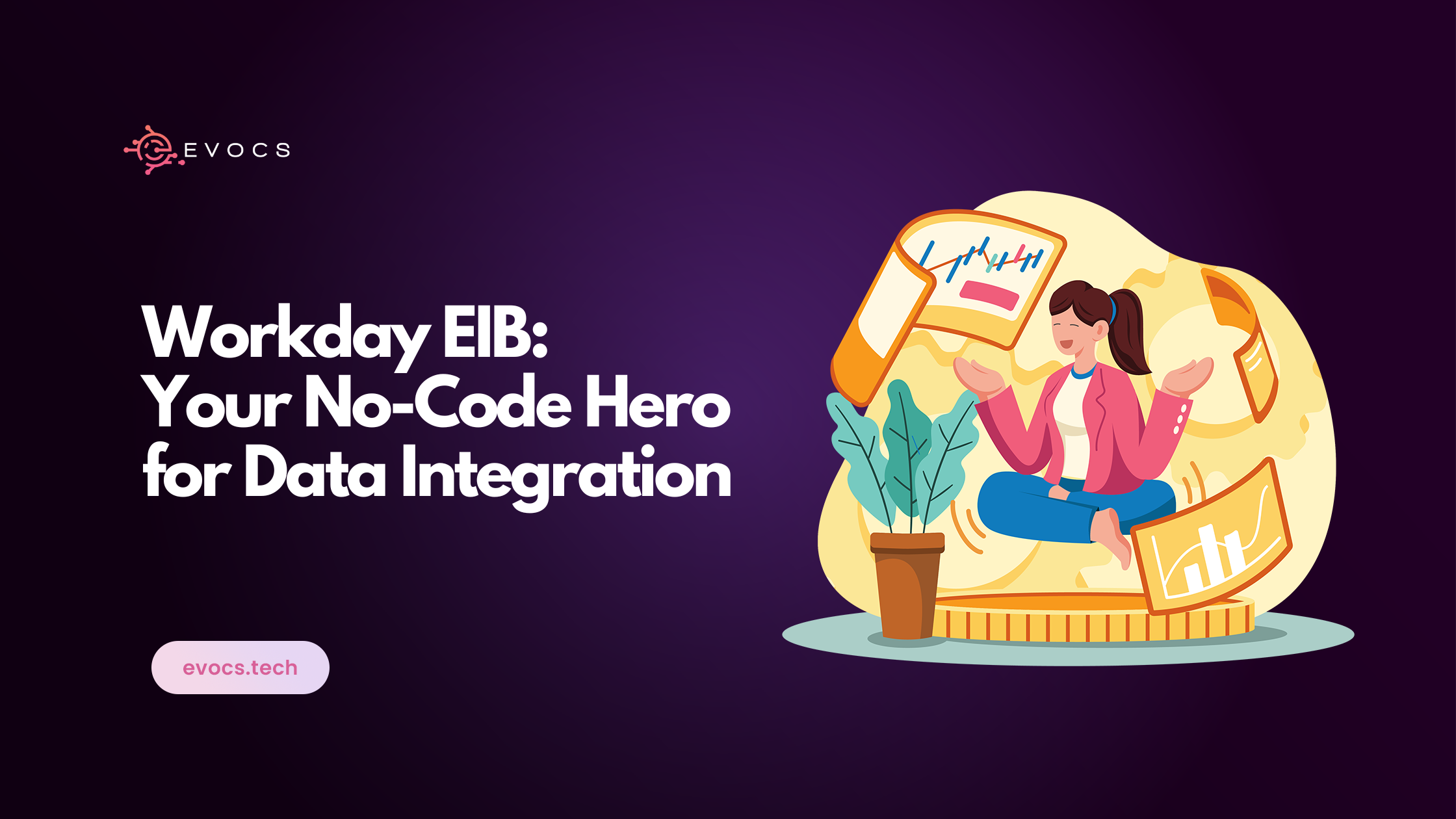
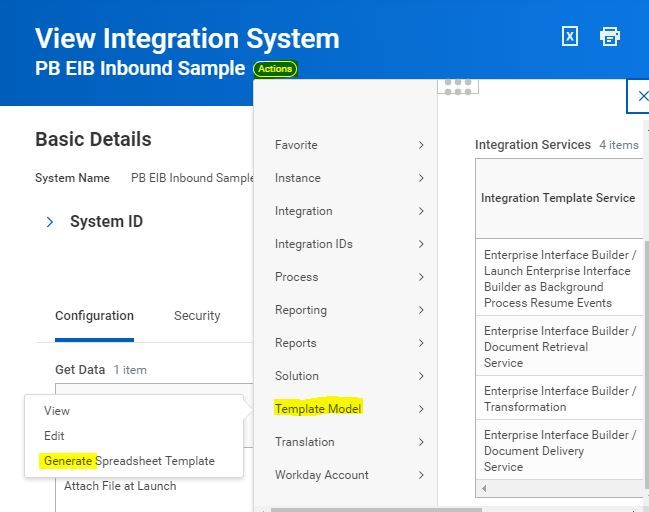
In the world of business, keeping things running smoothly is like making sure all the pieces of a puzzle fit together. If you use Workday, think of the Workday Enterprise Interface Builder (EIB) as your special tool – it helps pieces of information move around easily, kind of like a conveyor belt for data. It’s a simple way to connect Workday with other systems, so you don’t have to worry about things getting mixed up. Think of EIB as your helpful guide, making sure everything stays organized in the business puzzle!
But what exactly is Workday EIB, and why should you care? Buckle up, as we dive into this no-code marvel:
What is Workday EIB?
Imagine a bridge connecting your Workday platform to various other systems – payroll tools, talent management platforms, and even your legacy HR systems. That’s Workday EIB in a nutshell! It’s a visual, no-code interface that empowers you to create inbound and outbound integrations without needing to write a single line of code. You can easily:
Extract data: Pull employee information, payrolls, or any other data from Workday to external systems.
Load data: Upload data from external systems into Workday, keeping your records up to date.
Automate workflows: Streamline processes by automatically triggering data transfers based on specific events.
Why Go No-Code with EIB?
Sure, coding might be your superpower, but EIB democratizes data integration. Even business users with minimal technical expertise can:
Build integrations independently: No more waiting for IT resources! Craft integrations yourself, reducing bottlenecks and boosting agility.
Increase accuracy and reduce errors: Manual data entry is a recipe for mistakes. EIB automates data flows, ensuring reliable and consistent information.
Save time and resources: Focus on strategic tasks while EIB handles the data legwork, freeing up your valuable time.
What makes Workday Enterprise Interface Builder special?
Workday Enterprise Interface Builder (EIB) isn’t your typical data integration tool—it’s like that friendly colleague who makes everything easier. Here’s why it’s special:
User-Friendly:
Think of EIB as your tech-savvy friend who speaks your language: It’s a drag-and-drop, visual interface that skips the complex code. This means both IT wizards and business folks can weave integrations without needing coding expertise.
Guidance at Every Step: EIB is like a patient tutor, guiding you through each stage. Even if you’re a beginner, you’ll feel at ease navigating and creating integrations.
Ready-Made Pieces: EIB comes with a treasure trove of connectors and templates, saving you from the hassle of starting from scratch.
Flexibility:
Data Moves Freely: EIB isn’t picky—it supports both bringing data into Workday and sending it out, whether you’re importing from Workday or exporting to it.
Connect Anywhere: It’s like a multilingual communicator, linking up with various data sources through different protocols like FTP, SFTP, SOAP, REST, and WebDAV.
Big Data? No Problem: EIB handles mountains of data efficiently, perfect for handling large loads and extractions.
Security and Reliability:
Locked Tight: EIB plays by Workday’s security rules, ensuring your data stays safe and only accessible to the right eyes.
Keep Tabs: With detailed logs and reports, you’ll always know what’s going on with your integrations.
Grows with You: As your needs expand, EIB scales up without slowing down performance.
Extra Perks:
Save Those Coins: Bye-bye, development costs! Since there’s no need for coding, EIB cuts down on integration expenses big time.
Quick Changes: Need to tweak something fast? EIB lets you modify integrations with speed, giving your business a nimble edge.
Crystal-Clear Data: EIB smooths out data sharing between Workday and other systems, giving you clearer insights.
Overall, Workday EIB is a champ in being user-friendly, flexible, secure, and budget-friendly. It’s like the Swiss Army knife for maximizing Workday’s powers and keeping your data shipshape. While other tools exist, EIB stands out by being friendly, seamlessly fitting into the Workday family, and appealing to a wider audience.
EIB DESIGN PATTERN

There are three components to the EIB design pattern.
Data Source:
There are several options for retrieving data:
Outbound Options:
Workday Custom Report: Extracts data from existing Workday reports.
Workday Web Service API: Accesses data directly from Workday’s services.
Inbound Options:
Attachment: Receives data attached to an EIB notification.
(S)FTP(s)-based file: Retrieves data from secure file transfer servers.
REST URL: Fetches data from external systems using RESTful APIs.
Transformation:
There are also multiple options for transforming data using the EIB:
Alternate Output Format: Converts data into various formats like CSV or XML.
Custom Report Transformation: Applies custom logic to modify report data.
Custom XSLT: Uses XSLT to transform XML data according to specific rules.
Deliver Data:
Workday also provides a few different transport protocols:
Outbound Options:
Workday Attachment: Attaches data to an EIB integration for delivery within Workday.
(S)FTP(s): Sends data to secure file transfer servers.
HTTP(s): Transmits data over the web using secure protocols.
Email: Delivers data via email notifications.
AS2: Uses the AS2 protocol for secure business-to-business data exchange.
Inbound Options:
Workday Web Service API: Inputs data directly into Workday’s services.
Custom Object API: Integrates with custom objects on Workday.
Structure of EIB:
The Workday Enterprise Integration Bus (EIB) is a central platform for integrating Workday with other systems. It provides a set of services and tools that make it easy to connect Workday to external applications, databases, and other systems.
Advantages of EIB:
Workday Enterprise Interface Builder:
A tool used for data management within the Workday human capital management (HCM) system. Its advantages include:
Improving data accuracy and consistency: Workday EIB automates data loading and extraction, reducing the risk of errors and ensuring data integrity.
Saving time and effort: Workday EIB eliminates the need for manual data entry and manipulation, freeing up time for other tasks.
Increasing flexibility: Workday EIB can be used to integrate data with other systems, providing a single source of truth for all employee information.
Enhancing reporting and analytics: Workday EIB makes it easy to extract and analyze data, enabling businesses to make better decisions about their workforce.
Unleashing the Power of EIB
The use cases for Workday EIB are as diverse as your business needs. Here are just a few examples:
- Synchronize employee data with payroll systems.
- Integrate background check results into the hiring process.
- Update your Workday system with real-time sales data.
- Automated employee onboarding and offboarding.
Before Starting EIBs
Certainly! Before starting EIBs (Enterprise Interface Builder) on a Workday, there are several considerations to keep in mind. Here’s a checklist to guide you through the initial stages:
Consideration 1: What data source should you use?
The EIB leverages web services and custom reports as data sources. Through the Workday public API, web services data providers can obtain data from Workday by performing a Get or Put action. Although they take more work to set up, custom report data sources offer greater flexibility. Many of the fields offered by web services and custom reports in Workday require you to enter a value.
Consideration 2: How should you send the data to the external endpoint of an outbound EIB?
Make sure that the transport protocol of your EIB is compatible with your external endpoint. Example: SFTP and HTTPS.
Case Scenario: Workday & Bonusly Integration for Recognition & Rewards
Case Scenario:
Company: ACME Inc., a global software development firm with 5,000 employees across 10 countries.
Challenge:
ACME Inc. uses Workday for HR management, payroll, and performance appraisals. They struggle with a fragmented recognition system, relying on manual spreadsheet tracking and ad-hoc bonus payments. This leads to:
Low employee engagement: Recognition feels inconsistent and infrequent, demotivating employees.
Administrative burden: HR spends significant time managing spreadsheets and approvals.
Lack of transparency: Recognition data is siloed, hindering data-driven decision-making.
Solution:
ACME integrates Workday with Bonusly, a cloud-based platform for peer-to-peer recognition and rewards.
INT Worker Bonusly Integration Outbound | ||
1. | Integration Type | Workday Enterprise Interface Builder (EIB) |
2. | Scope (Data to Include) | Focus on active workers, not contingent workers. Capture data for active workers, working under manager any department/organization info within the last day. |
3. | Output Format | It’s a CSV (comma-separated) text file with fields in double quotes, arranged according to Vendor Field names listed in the header. The formatting happens through document transformation, not via an integration attribute in the Core Connector Worker. |
4. | Delivery | Host. sftp://demo-sftp.xxxx.net (not real) Directory: /root Username and Password will be provided. |
5. | Filename | INT_Worker_Bonusly_[MM][DD][YYYY]_ [Sequence Number].csv Note: The filename of the output from the CCW is not graded. |
6. | Schedule | Every day at 8 pm, including weekends, in the class’s time zone. Set the schedule to begin any day of the class week and end a year later. |
CR INT Worker Bonusly Integration Outbound | |||
S. No | Business Object | Fields | Column Heading Override |
1. | Worker | Employee ID | external_unique_id |
2. | Worker | First Name | first_name |
3. | Worker | Last Name | last_name |
4. | Worker | Preferred First Name | preferred_first_name |
6. | Worker | Email-Primary work | |
7. | Primary Work Address -Country | Alpha 2 code | country |
8. | Worker | Month and Day of Birth | date_of_birth |
9. | Worker | Business Title | business_title |
10. | Worker | Supervisory Organization | organization |
11. | Worker | Cost Center | department |
12. | Worker | Hire Date | hired_on |
13. | Worker | Management level | role |
14. | Worker | Location-Name | location |
Steps:
Configure the report for EIB:
Search the “Create custom report” task in the search bar and click ok. Enter the Name and select advanced in type. Also, enable report as a web service by checking the box, selecting data source as all active employees, and clicking ok.

Configure fields of the report:
Now we will enter all the fields in the report and click ok.

Configure EIB:
Search “Create EIB” task in the search bar and click ok. Enter the Name of EIB, select outbound by clicking on the radio button, and click ok.

Configure steps of EIB:
General Setting
The first step of EIB is general setting the name and the ID will automatically be filled up we will leave it as it is. If you want to add any comment you can click next.

Get Data
The second step is getting data, in which we will get data from the report that we created now we will call that report here by entering the name of that report in the custom report tab. If the report is not shown here, it means we have not enabled that report as a web service. To call that report here we should enable the report as a web service. In the details section we will specify the alternate output format in our case we will use CSV and click next.

Transform
The third step is transformation we will select none because we are not doing any transformation we will leave it as it is and click next.

Delivery
The next step is the delivery step in which we will select the delivery method as SFTP and enter the SFTP address, The Authentication method will be username/ password, enter the name of the file end it with .csv, and click next.
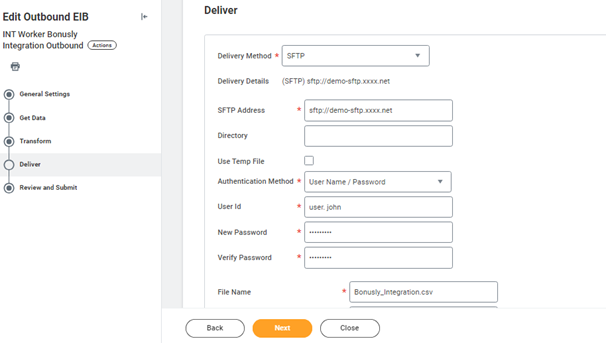
Review and Submit
The final step is to review all the steps we entered. You can check whether the entered steps are correct or not if the steps are not correct you can go back and fix your entries otherwise, we will select ok if our steps are correct.
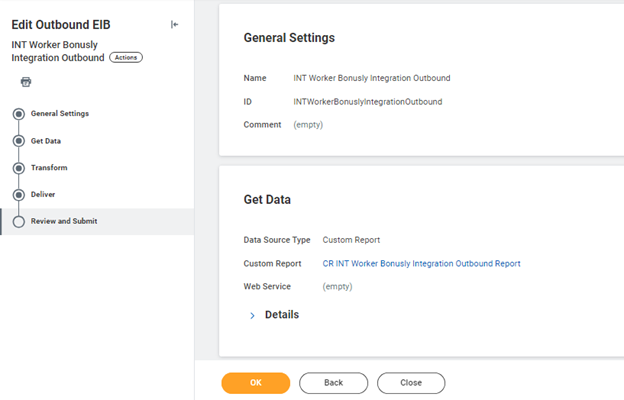
Launch / Schedule the EIB Run:
According to requirements you want the EIB to run and send data to the vendor every day so the running frequency should be a daily recurrence.
Now from the related actions, Integration > Launch / Schedule to Schedule the EIB execution through Workday’s Integration Cloud.
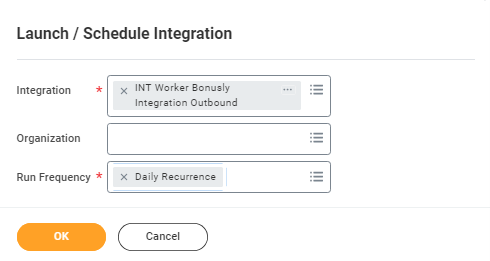
Schedule the EIB:
According to requirements. EIB must send data to the vendor daily at 8 pm and the range of recurrence should be one year.

Additional Considerations:
Security: Implement appropriate security measures to protect sensitive employee data during transmission and storage.
Error Handling: Define error handling procedures to address potential issues with data extraction, transformation, or delivery.
Documentation: Document the setup and configuration of the integration to ensure smooth maintenance and future updates.
This scenario is just one example of how the EIB can be used. Its flexibility allows you to tailor it to your specific needs and send various types of data to different external systems, promoting seamless data exchange and enhancing your business operations.

